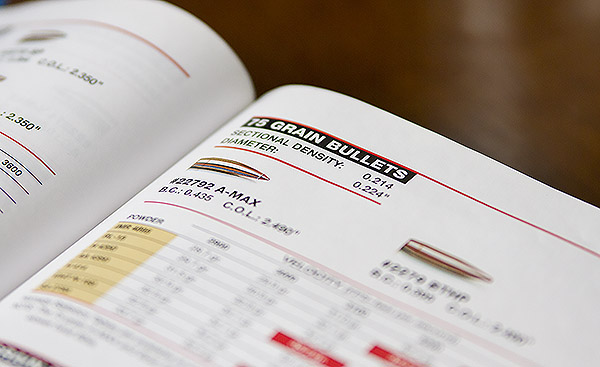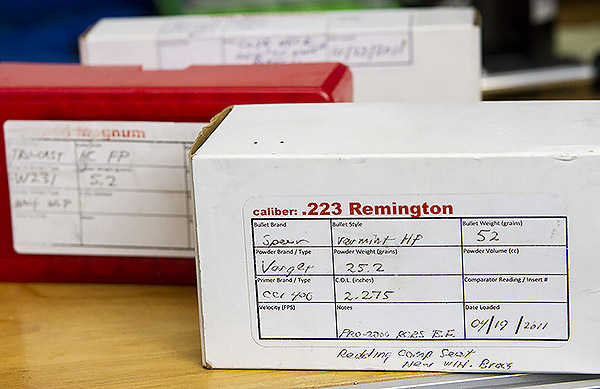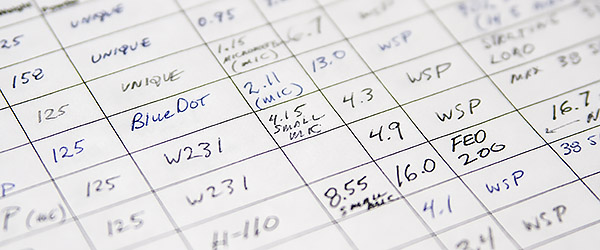One of the most vital aspects of ammunition reloading is good load data. If you want to know what components to buy, attain maximum performance, and be safe at the same time you need to have access to quality load data. Your load data is one of your greatest assets as a reloader! In this article I’ll discuss how to find load data, and how to ensure your load data is appropriate and safe. I’ll also talk a bit about record keeping and archiving of your load data.

Getting Started: Understand Your Cartridge and Gun
The first thing you’ll want to do when you go to find load data is to understand the cartridge you’ll be loading for and the gun or guns that you’ll be using the ammunition with.
Here are some things to think about related to your cartridge and gun (this will help you interpret and select appropriate load data):
- Is the firearm a semi-auto? If so, powder burn rate, overall power level, and bullet weight need to be matched to your firearm. You’ll also want to be aware of magazine dimensions that could affect maximum COL (Cartridge Overall Length)
- What is the age of the firearm? Was it designed before modern more high power loads were developed? If so, proceed with caution and prefer lower power levels. Newer +P rated pistols can take hot loads, but be *extremely* careful if you load +P ammunition so that it doesn’t end up in a non +P firearm!
- What type of bullets are you loading? If you are loading lead bullets you’ll want to do extra research so that you can ensure your safety and also avoid loads that can cause heavy leading (a function of the lead bullet expanding and sealing against the barrel grooves). If you are loading plated bullets, be aware that there are max FPS ratings and pushing these bullets beyond certain speeds can cause the plating to blow off (dont’ ask me how I know that). For plated bullets, always read the bullet manufacturer’s notes!
- Are you loading for plinking, precision, hunting, defense or other purposes? Make sure you understand what performance requirements you’re after, and be sure to seek others’ experience for “critical loads”
There are plenty more considerations, but these will get you pointed in the right direction!
Finding Load Data
There are several places to find load data. The most important thing to keep in mind is to ensure that you get load data from a reputable source, and always cross reference load data to protect yourself from mishaps (kind of like measure twice and cut once).
Here are some great places to find load data:
- Loading manuals from bullet and reloading equipment manufacturers like Hornady, Speer, and Lee
- Load data from powder manufacturers like Hodgdon and Alliant
- Websites with user-submitted load data like Handloads.com (always cross-reference!)
- Friends and online forums (always cross-reference)
- Your own records (so keep good records!)
Loading manuals are a must-have because they give an overview of each cartridge (handy for things like brass trim length and COL calculation) and also provide data specific to particular bullets. I like to complement these manuals with other sources like powder manufacturer’s websites and online discussions/forums. More data to consider is better, just remember to double/triple/quadruple check everything from primers to brass (remember, .223 and 5.56 don’t have the same strength or capacity!) to bullets, to primers, to powder type and charge, and cartridge dimensions as well. Don’t leave anything to chance!
Once you have load data, the next thing is to keep track of it near term, and over the years!
Managing Load Data
Every time you try out new loads you have the opportunity to add to your own personal “library” of load data. In order to get the most out of your reloading and shooting it pays to keep good records of your load data. You’ll find this information to be invaluable down the road when you go to load for a particular application or when a friend needs trusted load data. The more information you record the better as this will help you refine your craft, and also enable you to easily find what you need when you go to reference your data down the road.
Here are some ways that I like to manage my load data:
- Keep detailed records when you try a new load. I print out a table from an Excel spreadsheet that I use to manually write down load data.
- Label your ammo boxes will all pertinent load and cartridge information. This enables you to scan load data by perusing your ammunition stockpile! If you are looking for free ammo box labels, you can find them in my previous blog post.
- When you reference online load data sources, print out the relevant pages and annotate them with notes. These printouts should go in your load data binder along with your specific load data ledger sheets.
- Add notes to your load data ledger when possible. Did your 30-06 load perfectly expand when you took that elk? Write a quick note in your ledger describing the bullet’s performance. Chronograph results from range trips are another good note to add. Don’t forget felt recoil and group sizes either!
Here’s a look at some of my ammo boxes showing some notes that I like to add when loading:

And here’s an example of the load data ledger that I fill out for each loading session (when I’m not being lazy):

Looking forward, I’m going to refine my load data archive process. I’d love to be able to access and add to my load data ledger from anywhere from any device. I’m thinking to create a new and improved Excel spreadsheet that I can view and edit from my studio PC, my Windows Phone, and other devices. I’m thinking SkyDrive will be where my load data ledger will live! When I test this new spreadsheet out I’ll share with you all as a free download, so stay tuned.
Do you have a load data management process, resource, or tip that you’d like to share? Please leave a comment!
Thanks,
Gavin


















































































do you have load data for the 300 AAC Blackout. using 180-210gr wt bullets . There is very little out there so Im working on some loads from the load data out there.
Cant wait for the load data spreadsheet. Do you have a downloadable version as in the pic?
Thanks, Larry
I’m hoping to have the new version completed soon- check back here shortly 🙂
For recording the loads for various runs, I write them in a notebook using a LiveScribe pen, which syncs to Evernote. All of my reloading notes are available on any platform, phone, PC, etc.
For a big run of ammo, I print the labels using a Dymo label printer, the software for that stores the labels that I make. That allows me to just select a previous label and see the load parameters, then print more labels at the end of the new run.
Nice, sounds like you have some good technology to help you out! How do you upload the data from the LiveScribe pen to your device?
I follow many of the procedures you do, and am pleased that my sources and ways of confirming information are also like yours. I have obtained a few older loading books because I find some loads or powders have disappeared from newest versions; likely due to legal concerns. HOWEVER, one must do die diligence as sometimes loads change because of changes in formulations of powder, or other issues. This means start lower than usual on first loads with these older recipes. Having said that, the older manuals have afforded me a few options for certain bullets (especially lead bullet loads) that more recent editions have dropped. I keep records in a steno book of each load and how it shot in a specific firearm so I can quickly see how they shot. I can’t wait for a spreadsheet to organize this data. I can’t agree with you more that you must check and measure and recheck your memory and measurements constantly.
I can add, I also keep data on each load how dirty the residue is on the firearm, my hands, amount of muzzle blast, leading or other issues that are remarkable. For example, nuzzle flash can matter when hunting. So this misc. data is also written at the time. You cannot trust your memory even an hour later. I have a notebook (or others might use a modern recording device) available after every shot you are working up.
Good points – muzzle flash is also critical for self defense ammo!
Hi,
How accurate are the powder equivalent charts that powder suppliers use? Locally I can only source ADI powder yet it is rarely referenced in handbooks for load development.
Thankyou
Paul
Hey, do you have any Load Data for the 9mm ammo ??
I really need it for accuracy.
If you can provide me one, that will really helpful for me.
also, keep up great posting as well 🙂